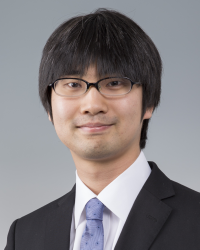ロボットの構成要素であるセンサ、プロセッサ、アクチュエータ等のデバイスをそれぞれ生体分子により実装し、さらに統合したシステムを分子ロボットと呼んでいる[1]。分子ロボットは状況に応じて形状を変えたり分子を放出するような機能を有するスマートマテリアルの一種であり、その生体適合性から医療をはじめとする様々な応用が期待されている。
分子ロボットを構成する主な生体材料は、核酸、タンパク質、脂質、高分子ゲルであり、それらを適切に組み合わせたナノ~マイクロサイズのシステムが考案されている。期待の機能を持つ分子ロボットを開発するためには、材料となる生体分子を寄せ集めただけでは不十分であり、分子デバイス同士の相互作用を不足なく設計する必要がある。すなわち生体分子の相互作用をプログラミングする必要があり、その設計支援に分子動力学シミュレーションや化学反応シミュレーションが活用されるため、本研究分野は生化学、ロボティクスと情報科学の融合領域といえる。
本講演では、我々が開発した分子ロボット、特にDNA分子の相互作用をプログラムしたデバイスを紹介する。例えば、DNAオリガミ[2]と呼ばれる超微細なナノ構造を作製する技術を使った変形デバイスを紹介し、培養したがん細胞に対する応用実験について述べる[3-4]。また、分子によって計算を行うDNAコンピュータの技術を使って、微小管の運動を制御した近年の研究についても紹介する[5]。
A molecular robot is a system that integrates devices where each of the components of robots, such as sensors, processors, and actuators are implemented using biomolecules [1]. Molecular robots are a type of smart material that can change its shape or release molecules depending on the environment and are expected to find a variety of applications in medicine and other fields thanks to their biocompatibility.
The main biomaterials that constitute molecular robots are nucleic acids, proteins, lipids, and polymer gels, while nano to micro-sized systems that appropriately combine these materials have been devised. To develop molecular robots with the expected functions, it is not enough to simply assemble the materials made of biomolecules, whereas it is necessary to design the interactions between molecular devices without deficiency. In other words, we need to program the interaction of biomolecules, and thus molecular dynamics simulations and chemical reaction simulations are harnessed to support the design, meaning that the field of molecular robotics is truly interdisciplinary that requires the expertise of Biochemistry, Robotics, and Information science.
In this talk, I will introduce our molecular robots, especially devices where the interactions of DNA molecules are programmed. For example, I will introduce a deformable device fabricated using DNA origami [2], a technology to build precise nano-scale structures, and describe its application toward cultured cancer cells [3-4]. I will also introduce recent research on the control of microtubule motion using DNA computer technology, in which calculations are performed by molecules [5].
[1] S. Murata, A. Konagaya, S. Kobayashi, H. Saito, M. Hagiya, Molecular Robotics: A New Paradigm for Artifacts. New Generation Computing, 31, 2013
[2] 川又生吹, 鈴木勇輝, 村田智, DNA origami入門 基礎から学ぶDNAナノ構造体の設計技法, オーム社, ISBN 978-4-274-22713-4, 2021
[3] D. Karna, E. Mano, J. Ji, I. Kawamata*, Y. Suzuki*, H. Mao*, Long-range Chemo-mechanical Force Modulates Higher Order Mesoscale Biostructures, Nature Communications, 14, 2023
[4] D. Karna, S. Watanabe, G. Sharma, A. Sharma, Y. Zheng, I. Kawamata, Y. Suzuki*, H. Mao*, Logic-Gated Modulation of Cell Migration via Mesoscale Mechanical Uncaging Effects, ACS Nano, 19, 2025
[5] I. Kawamata, K. Nishiyama, D. Matsumoto, S. Ichiseki, J. J. Keya, K. Okuyama, M. Ichikawa, A. M. R. Kabir, Y. Sato, D. Inoue, S. Murata, K. Sada, A. Kakugo, S. M. Nomura, Autonomous assembly and disassembly of gliding molecular robots regulated by a DNA-based molecular controller, Science Advances, 10, 2024
